 Supplying needed nutrients for crop production involves attention to four major fertilization factors (the 4Rs): right rate, right source, right placement, and right timing. Attention to these factors will provide adequate nutrition for crop production while minimizing the risk of loss of nutrients to the environment. In this publication each factor is described, as well as how the information can be provided from a soil test report. While not a formal part of the 4Rs, the importance of irrigation to overall nutrient management is stressed in this 4-page fact sheet written by George Hochmuth, Rao Mylavarapu, and Ed Hanlon, and published by the UF Department of Soil and Water Science, October 2014.
Supplying needed nutrients for crop production involves attention to four major fertilization factors (the 4Rs): right rate, right source, right placement, and right timing. Attention to these factors will provide adequate nutrition for crop production while minimizing the risk of loss of nutrients to the environment. In this publication each factor is described, as well as how the information can be provided from a soil test report. While not a formal part of the 4Rs, the importance of irrigation to overall nutrient management is stressed in this 4-page fact sheet written by George Hochmuth, Rao Mylavarapu, and Ed Hanlon, and published by the UF Department of Soil and Water Science, October 2014.
http://edis.ifas.ufl.edu/ss624
Tag: Edward A. Hanlon
Fertilizer Recommendation Philosophies
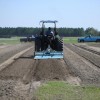 Farmers receive varying fertilizer recommendations depending on which lab they consult because labs employ different chemical methods and procedures to analyze the samples and subscribe to different fertilizer recommendation philosophies. This 4-page fact sheet explains the main soil-test philosophies, their basis, and their applications, and explains why the Sufficiency Level of Available Nutrient philosophy (SLAN), also called the Crop Nutrient Requirement (CNR), is most likely to be the best to govern fertilizer recommendations in Florida today. Written by George Hochmuth, Rao Mylavarapu, and Ed Hanlon, and published by the UF Department of Soil and Water Science, October 2014. (Photo by George Hochmuth, UF/IFAS)
Farmers receive varying fertilizer recommendations depending on which lab they consult because labs employ different chemical methods and procedures to analyze the samples and subscribe to different fertilizer recommendation philosophies. This 4-page fact sheet explains the main soil-test philosophies, their basis, and their applications, and explains why the Sufficiency Level of Available Nutrient philosophy (SLAN), also called the Crop Nutrient Requirement (CNR), is most likely to be the best to govern fertilizer recommendations in Florida today. Written by George Hochmuth, Rao Mylavarapu, and Ed Hanlon, and published by the UF Department of Soil and Water Science, October 2014. (Photo by George Hochmuth, UF/IFAS)
http://edis.ifas.ufl.edu/ss623
Soil Testing for Plant-Available Nutrients: What Is It and Why Do We Use It?
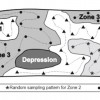 Farmers need soil-testing procedures to assess soils for potential plant-available nutrients. Soil testing is the foremost best management practice (BMP). It helps farmers achieve profitable crops while protecting the environment from excessive fertilization and nutrient losses. This 5-page fact sheet describes the important steps required to test soil for potential plant-available nutrients. Written by George Hochmuth, Rao Mylavarapu, and Ed Hanlon, and published by the UF Department of Soil and Water Science, October 2014.
Farmers need soil-testing procedures to assess soils for potential plant-available nutrients. Soil testing is the foremost best management practice (BMP). It helps farmers achieve profitable crops while protecting the environment from excessive fertilization and nutrient losses. This 5-page fact sheet describes the important steps required to test soil for potential plant-available nutrients. Written by George Hochmuth, Rao Mylavarapu, and Ed Hanlon, and published by the UF Department of Soil and Water Science, October 2014.
http://edis.ifas.ufl.edu/ss621
Developing a Soil Test Extractant: The Correlation and Calibration Processes
 An understanding of soil testing is an important part of preventing excess fertilizer applications that can potentially impact the environment and ensuring commercially viable yields and aesthetic, healthy landscapes. This 4-page fact sheet describes the process UF/IFAS soil scientists used to develop a predictive and/or diagnostic soil test that can be depended on by commercial agricultural and horticultural producers as well as homeowners and can provide accurate nutrient recommendations or diagnose nutrient imbalances for crops or plants. Written by George Hochmuth, Rao Mylavarapu, and Ed Hanlon, and published by the UF Department of Soil and Water Science, October 2014.
An understanding of soil testing is an important part of preventing excess fertilizer applications that can potentially impact the environment and ensuring commercially viable yields and aesthetic, healthy landscapes. This 4-page fact sheet describes the process UF/IFAS soil scientists used to develop a predictive and/or diagnostic soil test that can be depended on by commercial agricultural and horticultural producers as well as homeowners and can provide accurate nutrient recommendations or diagnose nutrient imbalances for crops or plants. Written by George Hochmuth, Rao Mylavarapu, and Ed Hanlon, and published by the UF Department of Soil and Water Science, October 2014.
http://edis.ifas.ufl.edu/ss622
Soil pH Management for Optimum Commercial Fruit Production in Florida
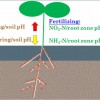 Soil pH is one of the most important soil chemical properties and affects nutrient bioavailability and microbial activity. The purpose of this article is to provide an overview for faculty, crop consultants, crop advisors, fruit growers, and students who are interested in fruit production. The crop response to soil pH varies due to crop genetic diversity. Soil pH determines nutrient bioavailability and hence fruit growth, yield, and quality. This 6-page fact sheet was written by Guodong Liu, Rao Mylavarapu, Ed Hanlon, and Wei Chieh Lee, and published by the UF Department of Horticultural Sciences, April 2014.
Soil pH is one of the most important soil chemical properties and affects nutrient bioavailability and microbial activity. The purpose of this article is to provide an overview for faculty, crop consultants, crop advisors, fruit growers, and students who are interested in fruit production. The crop response to soil pH varies due to crop genetic diversity. Soil pH determines nutrient bioavailability and hence fruit growth, yield, and quality. This 6-page fact sheet was written by Guodong Liu, Rao Mylavarapu, Ed Hanlon, and Wei Chieh Lee, and published by the UF Department of Horticultural Sciences, April 2014.
http://edis.ifas.ufl.edu/hs1234
Energy Valuation Methods for Biofuels in South Florida: Introduction to Life Cycle Assessment and Emergy Approaches (SL377/SS579)
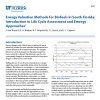 This 5-page fact sheet gives an overview of two methods for evaluating energy transformations in biofuels production. The Life Cycle Assessment approach involves measurements affecting greenhouse gases, which can be linked to the energy considerations used in the Emergy Assessment. Although these two methods have their basis in energy or greenhouse gas emission evaluations, their approaches can lead to a reliable judgment regarding a biofuel process. We can use them to evaluate the economic environmental component of a biofuel process, and decide which biofuel processes favor sustainability. The intended audiences of this publication are growers, researchers, students, and any other readers interested in agriculture and ecology. Written by J. Van Treese II, E. A. Hanlon, N. Y. Amponsah, J. L. Izursa, and J. C. Capece, and published by the UF Department of Soil and Water Science, March 2013.
This 5-page fact sheet gives an overview of two methods for evaluating energy transformations in biofuels production. The Life Cycle Assessment approach involves measurements affecting greenhouse gases, which can be linked to the energy considerations used in the Emergy Assessment. Although these two methods have their basis in energy or greenhouse gas emission evaluations, their approaches can lead to a reliable judgment regarding a biofuel process. We can use them to evaluate the economic environmental component of a biofuel process, and decide which biofuel processes favor sustainability. The intended audiences of this publication are growers, researchers, students, and any other readers interested in agriculture and ecology. Written by J. Van Treese II, E. A. Hanlon, N. Y. Amponsah, J. L. Izursa, and J. C. Capece, and published by the UF Department of Soil and Water Science, March 2013.
http://edis.ifas.ufl.edu/ss579
Understanding and Applying Chelated Fertilizers Effectively Based on Soil pH (HS1208)
 Plant nutrients are one of the environmental factors essential for crop growth and development. Nutrient management is crucial for optimal productivity in commercial crop production. Those nutrients in concentrations of ≤ 100 parts per million (ppm) in plant tissues are described as micronutrients and include iron (Fe), zinc (Zn), manganese (Mn), copper (Cu), boron (B), chlorine (Cl), molybdenum (Mo), and nickel (Ni). Micronutrients such as Fe, Mn, Zn, and Cu are easily oxidized or precipitated in soil, and their utilization is, therefore, not very efficient. Chelated fertilizers have been developed to increase micronutrient utilization efficiency. This 5-page fact sheet provides an overview of chelated fertilizers and considerations for their use to county Extension faculty, growers, and students who are interested in commercial crop production. Written by Guodong Liu, Edward Hanlon, and Yuncong Li, and published by the UF Department of Horticultural Sciences, November 2012.
Plant nutrients are one of the environmental factors essential for crop growth and development. Nutrient management is crucial for optimal productivity in commercial crop production. Those nutrients in concentrations of ≤ 100 parts per million (ppm) in plant tissues are described as micronutrients and include iron (Fe), zinc (Zn), manganese (Mn), copper (Cu), boron (B), chlorine (Cl), molybdenum (Mo), and nickel (Ni). Micronutrients such as Fe, Mn, Zn, and Cu are easily oxidized or precipitated in soil, and their utilization is, therefore, not very efficient. Chelated fertilizers have been developed to increase micronutrient utilization efficiency. This 5-page fact sheet provides an overview of chelated fertilizers and considerations for their use to county Extension faculty, growers, and students who are interested in commercial crop production. Written by Guodong Liu, Edward Hanlon, and Yuncong Li, and published by the UF Department of Horticultural Sciences, November 2012.
http://edis.ifas.ufl.edu/hs1208
Soil pH Range for Optimum Commercial Vegetable Production (HS1207)
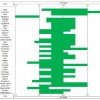 Soil pH affects nutrient bioavailability by controlling the chemical forms of nutrients. This 11-page fact sheet provides information about soil pH basics to commercial growers, county Extension agents, and college students specializing in vegetable production. Written by Guodong Liu and Edward Hanlon, and published by the UF Department of Horticultural Sciences, October 2012.
Soil pH affects nutrient bioavailability by controlling the chemical forms of nutrients. This 11-page fact sheet provides information about soil pH basics to commercial growers, county Extension agents, and college students specializing in vegetable production. Written by Guodong Liu and Edward Hanlon, and published by the UF Department of Horticultural Sciences, October 2012.
http://edis.ifas.ufl.edu/hs1207
Multiple-Use Landscapes: Reclaimed Phosphate Mined Lands (SL374/SS575)
 Phosphate mining is a temporary land use. The jobs and economic activity associated with mining depart an area once the resource is exhausted — but the landscape created as a result of mining and reclamation will exist in perpetuity. Communities affected by mining activities need to have reclamation result in lands with high potential to provide sustainable economic opportunities while maintaining ecosystem services and ecological functions. This 8-page fact sheet provides a brief overview of the landscapes being created as a result of phosphate mining and reclamation activities in Florida. Written by M. Wilson and E.A. Hanlon, and published by the UF Department of Soil and Water Science, October 2012.
Phosphate mining is a temporary land use. The jobs and economic activity associated with mining depart an area once the resource is exhausted — but the landscape created as a result of mining and reclamation will exist in perpetuity. Communities affected by mining activities need to have reclamation result in lands with high potential to provide sustainable economic opportunities while maintaining ecosystem services and ecological functions. This 8-page fact sheet provides a brief overview of the landscapes being created as a result of phosphate mining and reclamation activities in Florida. Written by M. Wilson and E.A. Hanlon, and published by the UF Department of Soil and Water Science, October 2012.
http://edis.ifas.ufl.edu/ss575
Florida Reclaimed Phosphate Mine Soils: Characteristics, Potential Uses, and Management Considerations (SL370/SS571)
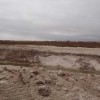 A critical nutrient for plant growth, phosphate helps sustain the world’s growing population. In 2010, seven mines in Florida produced approximately 10% of the world’s phosphate supply and more than 65% of the phosphate for the United States. But each year in Florida thousands of acres disturbed by strip-mining for phosphate rock must be reclaimed for other productive uses. This 11-page fact sheet provides a general characterization of the various soil types resulting from phosphate mine reclamation. Written by M. Wilson and E.A. Hanlon, and published by the UF Department of Soil and Water Science, October 2012.
A critical nutrient for plant growth, phosphate helps sustain the world’s growing population. In 2010, seven mines in Florida produced approximately 10% of the world’s phosphate supply and more than 65% of the phosphate for the United States. But each year in Florida thousands of acres disturbed by strip-mining for phosphate rock must be reclaimed for other productive uses. This 11-page fact sheet provides a general characterization of the various soil types resulting from phosphate mine reclamation. Written by M. Wilson and E.A. Hanlon, and published by the UF Department of Soil and Water Science, October 2012.
http://edis.ifas.ufl.edu/ss571
Carbon Sequestration in Grazing Land Ecosystems (SL373/SS574)
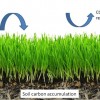 Native and improved pastures play an important role in sequestering carbon from the atmosphere. Because of the relatively high sequestration rates and extensive area, grazing land represents an important component of terrestrial carbon dioxide (CO2) offset and is a significant sink for long-term carbon sequestration and greenhouse gas mitigation. This 4-page fact sheet contains information for stakeholders, students, scientists, and environmental agencies interested in enhancing ecosystems services provided by grazing lands. Written by Maria Silveira, Ed Hanlon, Mariana Azenha, and Hiran M. da Silva, and published by the UF Department of Soil and Water Science, September 2012.
Native and improved pastures play an important role in sequestering carbon from the atmosphere. Because of the relatively high sequestration rates and extensive area, grazing land represents an important component of terrestrial carbon dioxide (CO2) offset and is a significant sink for long-term carbon sequestration and greenhouse gas mitigation. This 4-page fact sheet contains information for stakeholders, students, scientists, and environmental agencies interested in enhancing ecosystems services provided by grazing lands. Written by Maria Silveira, Ed Hanlon, Mariana Azenha, and Hiran M. da Silva, and published by the UF Department of Soil and Water Science, September 2012.
http://edis.ifas.ufl.edu/ss574
Landscape Diversity: Florida Phosphate Mine Pit Lakes (SL364/SS565)
 This 8-page fact sheet contains a synopsis of findings obtained through research, contrasted with limnological studies of natural lakes in central Florida. Written by M. Wilson and E.A. Hanlon, and published by the UF Department of Soil and Water Science, May 2012.
This 8-page fact sheet contains a synopsis of findings obtained through research, contrasted with limnological studies of natural lakes in central Florida. Written by M. Wilson and E.A. Hanlon, and published by the UF Department of Soil and Water Science, May 2012.
http://edis.ifas.ufl.edu/ss565
Engaging Youth in the Environment through the Florida Land Judging Program (SL362/SS563)
 The Florida 4-H/FFA Land Judging Contest is steeped in a tradition of enthusiastic participation, challenging science, and dynamic field conditions. Learn more in this 3-page fact sheet written by Amy L. Shober, L. Rex Ellis, Edward A. Hanlon, and Christine Wiese, and published by the UF Department of Soil and Water Science, November 2011.
The Florida 4-H/FFA Land Judging Contest is steeped in a tradition of enthusiastic participation, challenging science, and dynamic field conditions. Learn more in this 3-page fact sheet written by Amy L. Shober, L. Rex Ellis, Edward A. Hanlon, and Christine Wiese, and published by the UF Department of Soil and Water Science, November 2011.
http://edis.ifas.ufl.edu/ss563
Rules and Scorecard Grading Policies for the Annual Florida 4-H/FFA Land Judging Contest (SL144/SS195)
 This 11-page fact sheet outlines the rules of the annual Florida 4-H/FFA Land Judging Contest and guides participants in correctly completing the Land Judging and Homesite Evaluation scorecards. Written by Amy L. Shober, L. Rex Ellis, Christine Wiese, Edward A. Hanlon, Randy B. Brown, and J.H. Herbert, Jr., and published by the UF Department of Soil and Water Science, November 2011.
This 11-page fact sheet outlines the rules of the annual Florida 4-H/FFA Land Judging Contest and guides participants in correctly completing the Land Judging and Homesite Evaluation scorecards. Written by Amy L. Shober, L. Rex Ellis, Christine Wiese, Edward A. Hanlon, Randy B. Brown, and J.H. Herbert, Jr., and published by the UF Department of Soil and Water Science, November 2011.
http://edis.ifas.ufl.edu/ss195
Fertilizer Experimentation, Data Analyses, and Interpretation for Developing Fertilization Recommendations: Examples with Vegetable Crop Research (SL345/SS548)
 Fertilizer recommendations contain several important factors, including fertilizer form, source, application timing, placement, and irrigation management. Another important part of a fertilizer recommendation is the amount of a particular nutrient to apply. The optimum fertilizer amount is determined from extensive field experimentation conducted for several years, at multiple locations, with several varieties, etc. This 10-page fact sheet focuses on the research principles behind determining the optimum rate of fertilizer, including experimentation and interpreting research results for optimum crop production and quality in conjunction with minimal environmental consequences. Authors George Hochmuth, Ed Hanlon, and Allen Overman use examples from research with vegetable crops in Florida and emphasize that how one interprets the results is as important as how one conducts the research. Published by the UF Department of Soil and Water Science, October 2011.
Fertilizer recommendations contain several important factors, including fertilizer form, source, application timing, placement, and irrigation management. Another important part of a fertilizer recommendation is the amount of a particular nutrient to apply. The optimum fertilizer amount is determined from extensive field experimentation conducted for several years, at multiple locations, with several varieties, etc. This 10-page fact sheet focuses on the research principles behind determining the optimum rate of fertilizer, including experimentation and interpreting research results for optimum crop production and quality in conjunction with minimal environmental consequences. Authors George Hochmuth, Ed Hanlon, and Allen Overman use examples from research with vegetable crops in Florida and emphasize that how one interprets the results is as important as how one conducts the research. Published by the UF Department of Soil and Water Science, October 2011.
http://edis.ifas.ufl.edu/ss548
Landscape Diversity: Multiple-Use Landscapes for Reclaimed Phosphatic Clay Areas (SL229/SS449)
 With planning, communities can use reclaimed phosphatic clay areas for agriculture and at the same time restore lost wetlands, improve water quality and water use efficiency, and retain areas valuable to wildlife. This 5-page concept paper was written by E.A. Hanlon, M. Wilson, C. Beavers, and J. Cates, and published by the UF Department of Soil and Water Science, August 2011.
With planning, communities can use reclaimed phosphatic clay areas for agriculture and at the same time restore lost wetlands, improve water quality and water use efficiency, and retain areas valuable to wildlife. This 5-page concept paper was written by E.A. Hanlon, M. Wilson, C. Beavers, and J. Cates, and published by the UF Department of Soil and Water Science, August 2011.
http://edis.ifas.ufl.edu/ss449
A Summary of N, P, and K Research with Tomato in Florida (SL355/CV236)
 More than 60 years worth of tomato fertilization research has been conducted in Florida. During this time, many changes have occurred in tomato production practices, including changes in cultivars and the introduction of new cultural systems, such as polyethylene mulch and drip irrigation. The research reported here covers tomato production with polyethylene mulch. Tomato crop and fertilizer management recommendations, such as plant and row spacing, have changed over time following new developments in research. This 38-page fact sheet summarizes tomato fertilization research leading to current University of Florida recommendations and summarizes needs for additional research. Written by George Hochmuth and Ed Hanlon, and published by the UF Department of Soil and Water Science, August 2011. (UF/IFAS Photo by Tyler Jones)
More than 60 years worth of tomato fertilization research has been conducted in Florida. During this time, many changes have occurred in tomato production practices, including changes in cultivars and the introduction of new cultural systems, such as polyethylene mulch and drip irrigation. The research reported here covers tomato production with polyethylene mulch. Tomato crop and fertilizer management recommendations, such as plant and row spacing, have changed over time following new developments in research. This 38-page fact sheet summarizes tomato fertilization research leading to current University of Florida recommendations and summarizes needs for additional research. Written by George Hochmuth and Ed Hanlon, and published by the UF Department of Soil and Water Science, August 2011. (UF/IFAS Photo by Tyler Jones)
http://edis.ifas.ufl.edu/cv236
A Summary of N, P, and K Research with Potato in Florida (SL346/CV233)
Potato fertilization research has been conducted in Florida for more than sixty years. During this time, changes have occurred in potato production practices including new cultivars, refinements in fertilizer application timing, use of fertilizer recommendations based on soil nutrient analysis, use of nematicides, and improved weed and pest management practices. This 33-page fact sheet summarizes potato fertilization research leading to current University of Florida recommendations and summarizes needs for additional research. Written by George Hochmuth and Ed Hanlon, and published by the UF Department of Soil and Water Science, April 2011.
http://edis.ifas.ufl.edu/cv233
A Summary of N and K Research with Strawberry in Florida (SL344/CV229)
More than 50 years worth of strawberry fertilization research has been conducted in Florida. This revised 25-page fact sheet reviews literature from all sources that pertain to commercial strawberry fertilization in Florida’s growing conditions. Written by George Hochmuth and Ed Hanlon and published by the UF Department of Soil and Water Science, March 2011.
http://edis.ifas.ufl.edu/cv229
A Guide to EPA’s Numeric Nutrient Water Quality Criteria for Florida (SL316/SS528)
This revised 10-page guide provides a basic, concise, and understandable description of the United States Environmental Protection Agency’s (EPA) numeric nutrient criteria for Florida, the background events that led to its release, some pertinent scientific issues, and implications for the future. Written by Thomas Obreza, Mark Clark, Brian Boman, Tatiana Borisova, Matt Cohen, Michael Dukes, Tom Frazer, Ed Hanlon, Karl Havens, Chris Martinez, Kati Migliaccio, Sanjay Shukla, and Alan Wright, and published by the UF Department of Soil and Water Science, March 2011.
http://edis.ifas.ufl.edu/ss528